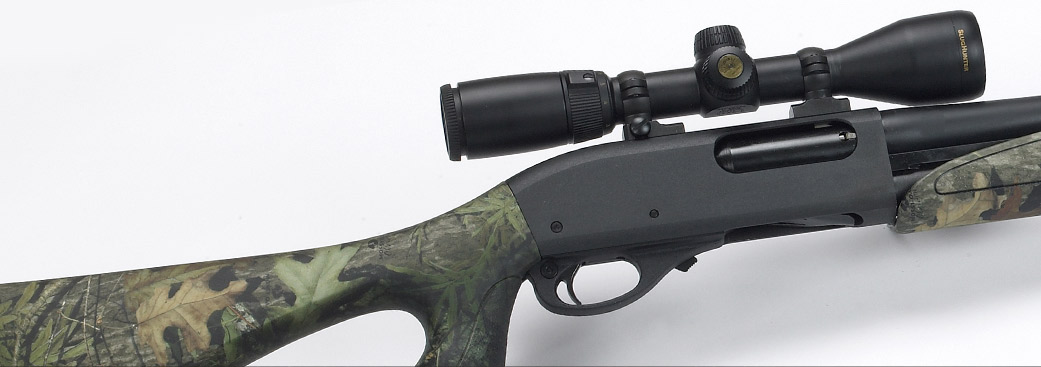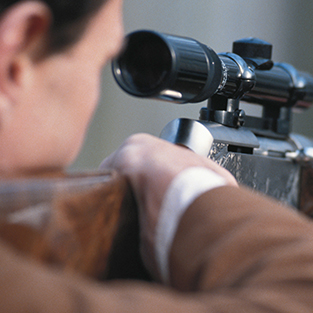
Slug guns must be zeroed (sighted-in) at a distance where the slug will impact the target while still in the supersonic phase of its flight. Most slugs become subsonic, travelling less than 1220 feet per second, slightly beyond a muzzle distance of 50 yards, thus making 50 yards the ideal zeroing distance. Zeroing at 50 yards also cuts down, by approximately 60%, the chance of adjusting Windage error into your scope setting.
A common shortcut taken by a majority of shooters is the attempt to zero their guns at 100 yards. This is a serious mistake as several significant factors come into play that will prevent an accurate zero at this distance in all cases. When zeroing a slug gun at 100 yards only, you never know how much Windage is turned into your scope setting. Your gun becomes effectively sighted in for that day’s wind only, and your point of zero could be as much as 6 to 20 inches off of where it should be at 100 yards.
Zero your gun at 50 yards, 2-3/4″ high of absolute dead center on your target…no left, no right, simply 2-3/4″ high. You will then be dead-on zeroed at 100 yards because gravity will see to it. Check trajectory data for the brand of ammunition you are shooting and adjust the height of your 2-3/4″ 50 yard true zero as necessary so as to produce a dead-on gravity zero at 100 yards.
Once your gun has been zeroed at 50 yards, you should fire the weapon at a range of 100 and then again at 150 yards so that you can get a feel for how negative factors, such as wind drift, will affect your shot placement. A perfect hold at 100 yards may now produce a target impact as far as 6 to 8 inches off your point of aim, but since your gun has been precisely zeroed at 50 yards, you can be assured that this drift was caused by the effect wind of the day. Wind has more effect than most shooters realize on the flight of a large, relatively slow moving projectile such as a slug. Learning how to compensate for differing wind velocities and angles, especially at extended distances, is a lesson that must be learned if you wish to be consistently successful hunter and shooter with a DSG.
Although any type of DSG with rifled barrels perform similarly to rifles, they are not rifles and cannot be zeroed as if they were. Even the fastest slug is significantly slower than the typical rifle bullet. It is therefore extremely important to apply back-pressure to the forend of the stock with your left hand while you are shooting. Not doing so will result in the barrel of your slug gun jumping into the air off of the front rest, moving your point of aim and ruining your shot alignment before the slug even has a chance to exit the barrel.
Let’s say you have zeroed your gun in this manner at 100 yards, adjusting into your scope setting this muzzle jump as well as Windage error. While in the field you shoot at a deer at 100 yards while holding onto the forend of your gun’s stock. Your shot hits low or, most likely, misses completely. Most would tend to blame the gun or the ammunition, when in reality methodology is the real culprit. Think about it! Learn to properly set up your equipment and you can be confident in your shot when the time comes.
Here is what it takes with a DSG to shoot the “allusive 1 inch group at 100 yards”, but only if the shooter…
- Can find a lot of sabot ammunition that matches your barrel;
- Has a good rest to shoot off of and has spent the time necessary to learn how to shoot well off of it;
- Can find a telescope that will continue to work for more than 100 rounds. Most slug gun shooters cannot tell when a scope has gone bad;
- Remembers that riflesare zeroed (sighted-in) at 100 yards and then checked at 200 and 300 yards while DSG’sare zeroed at 50 yards and then checked at 100 and 150 yards;
- Remembers to always use a range-finderprior to taking any shot longer than 100 yards;
- Will spend the time to learn the intricacies of shooting slugs at 100 yards. for example, a 10 mph crosswind moves a slug 5 to 6 inches at 100 yards. A tail wind causes the impact point of a slug to move up, and a head wind will move the impactpoint down. It is evident that the slug movement of 6 to 20 inches at 100 yards is common. To take this a step further, a 15 to 17 mph cross wind, typical of what one might encounter during a November/December deer hunt, will move a slug 9 to 12 inches at 100 yards and a full 24 inches at 150 yards.
